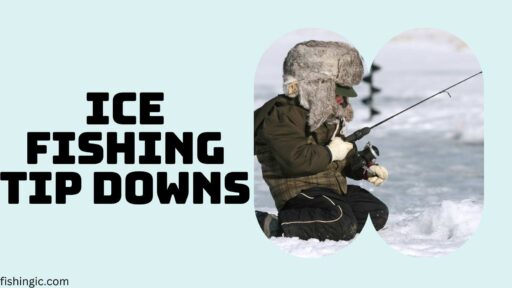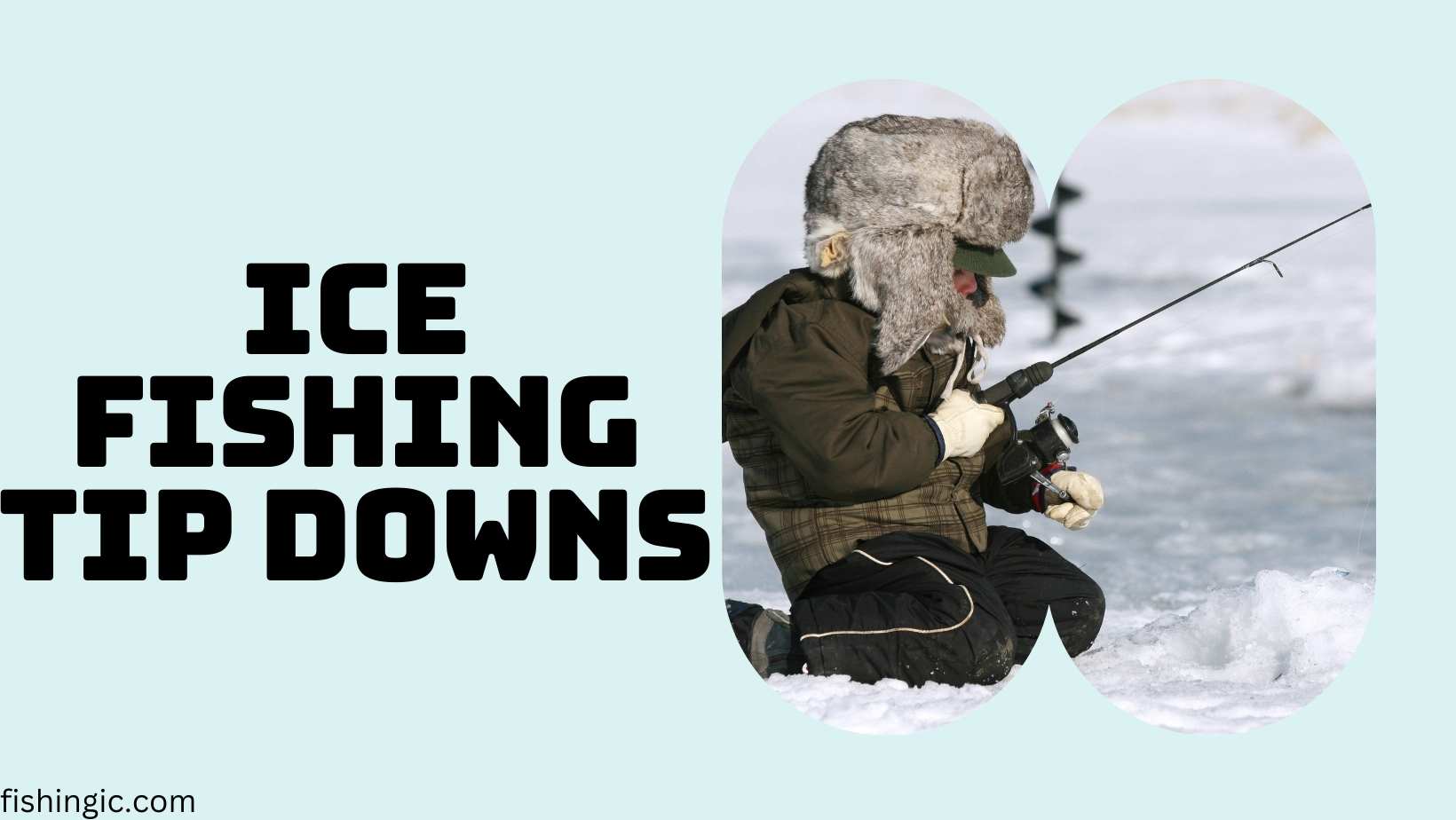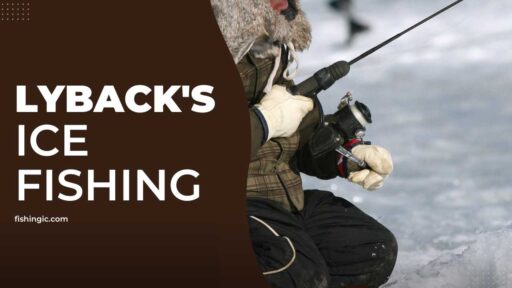Elevate your Ice Fishing Tip Downs game with our premium tip downs. Explore our range of products and learn valuable techniques for a successful catch.
Introduction to Ice Fishing Tip Downs
Are you interested in ice fishing but prefer a more passive approach? Look no further than tip downs for ice fishing! These ingenious devices are like silent guards, alerting anglers to bites with flagged signals. They are ideal for people who want to fish lazily or manage multiple holes at the same time because they provide a unique and effective way of catching fish under the ice. Keep reading to learn how to set up, use, and maintain your tip-downs for maximum success on your next frozen expedition!
Understanding the Mechanics of Ice Fishing Tip-Ups
Ice fishing tip ups consist of a flag as well as a rod holder with an arm that is horizontal. The flag goes up when the bait is bitten by a fish and it serves as an indicator. It is designed in such a way that it can hold tight the fishing rod. Once the redfin bites, the end of it sinks down thereby sending up the signal.
To understand how ice fishing tip ups works, it is important to understand how fish behave in cold water. Fish tend to move slowly and cautiously during winter making sensitive and responsive tip downs critical components. The horizontal arm on this kind of device allows even the faintest nibble to be detected hence you will not lose any potential catches.
Choosing the Right Ice Fishing Tip-Up for Your Needs
When choosing an appropriate ice fishing tip up there are several factors worth considering. First you need to know the depth of water where you will be going fishing at. This will help you choose one that has an appropriate line length. Also consider what types of species you are targeting as well as size requirements for bait.
The material used to make these devices is another important consideration. Although most models comprise metals or plastics made from sturdy materials, certain types possess adjustable tension or come equipped with built-in lights among other things. These aspects enhance ones overall experience while improving their likelihoods of successfulness when ice fishing.
Setting Up Your Ice Fishing Tip Up
Always ensure that the tip-up is properly set before heading out to the ice. Start by finding a good spot where fish tend to congregate. Look for areas with underwater structures or vegetation, as these provide hiding spots for fish. The next step will involve drilling a hole in the ice using an ice auger.
Afterward, insert the vertical support into the hole and make sure it is stable and secure. Then, thread your line carefully through the rod holder and attach your bait of choice at one end. Finally adjust the tension on your tip up such that it detects bites but does not trigger false alarms too often due to over-sensitivity.
Best Practices for Using Ice Fishing Tip-Ups
Ice fishing tip downs will be successful if people observe some best practices. First, one should be patient and wait for the fish to fully pick the bait before setting it. One mistake that is common is pulling the line too early and this leads to missed chances. In addition, you must maintain silence and minimize activity around your tip downs which can chase away fish.
Another advice is using different kinds of baits to attract various types of fish. Try using live baits such as minnows or worms as well as artificial lures to find out what works best in your fishing location. Besides, be sure to examine your tip downs on a regular basis since there might be flags which are up but not all the way.
Hence, here are several hints that will help you maximize your success with ice fishing tip-downs:
To have better results when ice fishing with a tip down; these tips and tricks can come handy for you as well. First things first pay attention to weather conditions. Periods of stable weather often activate fish so plan ahead for your ice fishing trips accordingly. Additionally, use different colors of bait until you find those that work best in your area.
Strategic positioning is also important when setting up these devices. Place them in deeper waters if targeting larger species, while those meant for smaller ones ought to be positioned at shallower ends. Vary depths and locations until the most productive spots are found.
Things Not To Do When Using Ice Fishing Tip Downs
There are several mistakes commonly made by people who use ice-fishing tip-downs wrongly, resulting into an unsuccessful and frustrating ice-fishing experience:
Wrong Line Choice: Weak lines may snap during powerful fights with fish making appropriate selection vital. Instead choose quality cold weather monofilament or braided line specifically made for hardwater angling rated at 8-15 pound test depending on target species size.
No Swivels: Live bait requires swivels in order to prevent line twisting and effective tip-down operation. Failure to use swivels will result into tangled lines and stop working bites.
Sinker That Is Too Light: When ice fishing, the hook might not set securely if sinkers are too light. Select sinkers that are ideal for the depth of water and the species being pursued. Heavier jigs or sinkers can improve hook setting.
Flag Overhaul Negligence: The flags often contain ice or become dirty and tend to stick, thereby failing to indicate a bite in case of any malfunction. Always make sure that your flag is freely moving at all times.
Don’t leave your hole uncleared since, as you fish, accumulating ice around the hole can freeze your line, thus preventing its movement. Therefore, periodically clear away any accumulated ice so that your line can move smoothly and detect a proper bite.
Pre-Season Maintenance Neglect: Poor inspection or maintenance of one’s tip-downs before the season starts may cause unexpected breakdowns on the ice. Do a visual examination carefully, check for weak points in lines, and lightly oil metallic areas (avoid petroleum-based lubricants).
Setting Too Many Tip-Downs: If you have multiple tip-downs, you can cover more area to increase your chances as a fisherman, but managing too many is overwhelming. When starting off with tip-downs, you are better off having a few. After gaining some experience, add the rest.
Improper Bite Detection: It is hard seeing a flagged line from afar when one does not use bright colored line markers or forgets about tip-up lights in low-light conditions. Improving bite visibility can be done by using contrasting line colors or small lights.
Forgetting Basic Ice Safety: One needs to be aware of the danger involved in ice fishing. Safety should always come first. Layer warmly, put on ice cleats for traction, and bring along ice picks as well as life jackets just in case you fall into the water.
Rushing to Set the Hook: The first temptation after a flag pops up is getting an urge to pull up the rod immediately. However, if a hook set is done too early with a tip-down, it may result in missed bites. Give some time for the fish to swim away before setting the hook; this will guarantee that your hookset is properly done.
Maintenance and Care for Your Ice Fishing Tip Downs
Here’s how to keep your ice fishing tip-downs working perfectly all season long:
Pre-Season Maintenance
Visual Inspection: Before putting away these units for summer, always inspect them visually carefully. Inspect all parts thoroughly for cracks, warps, or breaks. Tighten any loose screws or knots.
Line Check: Examine your fishing line for nicks, frays, or weaknesses. Replace any compromised line so that no strikes are missed during this season.
Reel and Spring Cleaning: Where there are reels on such tip-downs, remove dirt and other debris that might hinder the smooth operation of such devices; clean it up completely, then wipe down spring mechanisms against grime, which might make it less responsive to the fish. Lightly apply a silicone-based lubricant on any metal parts that rub together (do not use petroleum-based lubricants since they destroy the fishing line).
Post-Season Storage
Dry Thoroughly: Ensure your tip-downs have dried completely before storing them. Wetness can lead to rust or mildew growth.
Store Indoors: Keep your tip-downs in a cool, dry place out of direct sunlight. Do not expose them to extreme temperature fluctuations which can result in warping of components.
Winter Maintenance
Hole Clearing: After setting your tip-down, periodically clear away any accumulating ice around the hole to prevent freezing of the line and consequent inability to move.
Flag Functionality: Make sure that ice does not obstruct the movement of the flag on a tip-up.
Additional Tips
Spare Parts: Be ready for any breakages by having some staples like springs or flags kept safe for use during emergencies while on ice.
Transportation: While moving from one point to another one has to be cautious about one’s tip-downs so as not to cause damage on them. The best way is packing them properly so that they do not hit each other inside their container.
By following these simple maintenance practices, you will keep your ice fishing tip downs good for many years of winter adventures.
Recommended Gear and Accessories for Ice Fishing Tip Downs
Here are the items you need in order to gear up your ice fishing activities with tip downs:
Essential Tip-Down Accessories
Fishing Line: Select an ice-fishing rated cold weather monofilament or braid line with 8-15 pound test depending upon what size fish you’re after.
Swivels: Swivels are important because they prevent line twist making it easier especially when using live bait or lures with spinning action.
Sinkers: Different types of sinkers would be required for varying depths in water and different fish. Large jigs or sinkers are better when setting the hook through the ice hole.
Hooks: For your target fish, pick suitable hooks. Circle hooks should be considered when it comes to catch-and-release techniques. Size 1/0-3/0 hooks are a good place to start for most freshwater ice-fishing species.
Leaders: Fluorocarbon leader is designed to resist abrasion in the water and become invisible so that you can deceive suspicious fish. Use 20-30-pound leader material.
Optimizing Performance
Tip-Up Lights: Putting small tip-up lights on your flags will make them more conspicuous during low-light periods or night fishing. Chemical light Stick and small battery-operated LED lights are common options to use as well.
Line Markers or Spools: One could think about utilizing brightly colored line markers or little line spools with respect to enhancing bite detection in particular while using multiple tip-downs. This color against the snow can help you notice a flagged line from further away.
Additional Gear
Rod and Reel: You’ll need another ice fishing rod and reel since the tip down only alerts one of the bites but not fights with the fish that arise after a flag-up has been observed. A rod and reel should suit the size of your intended catch species.
Bait and Lure Selection: Minnows, waxworms, etc., may also be used for bait selection. Jigs, spoons, and blade baits all have their own special attractions when it comes to pulling fish through an ice hole.
Landing Net: A long-handled small landing net makes it easy to scoop up fish safely through an ice hole.
Bucket: A bucket is a multi-purpose tool that can hold live bait, store caught fish, mix chum bait, etc.
Comfort and Safety Gear
Warm Clothing: Wear ideal winter attire comprising layered warm clothing.
Ice Cleats: They get extra grip on slippery ice surfaces when walking easily around with them.
Spud Bar: Spud bar helps to break through thicker ice or check the depth of ice before drilling holes on it.
Safety Gear; Safety should be put first while on the ice. Carry an Ice pick and a life jacket in case you fall through the ice.
FAQs
Can I use ice fishing tip downs for any type of fish?
Different types of fish, such as perch, walleye, trout, pike, and others, can all be caught using an ice fishing tip down. However, it is important to check your fishery regulations to ensure that you are adhering to them.
How sensitive should the tip-down tension be?
A good rule of thumb is that the tension should be sensitive enough to detect hits and nibbles but not too sensitive so as to cause false alarms. You may have to experiment with some until you find what works best for your fishing conditions.
Can I use ice fishing tip-downs in shallow water?
Yes, they can also be used in shallow waters where anglers stand. Nevertheless, bear in mind that different depths might limit your choice of fish. Adjust bait and position accordingly.
Conclusion of Ice Fishing Tip Downs
The art of Ice Fishing Tip Downs can be mastered over time and with practice, but this guide will give you the skills and know-how to get you there. Don’t forget to select suitable ones for your needs, arrange them properly, and use the best practices available in order to increase your chances of catching fish. Ice fishing may become a rewarding and enjoyable winter sport if one exercises some patience, perseverance as well as a little bit of good fortune. Therefore, prepare yourself by wrapping up warmly, carrying all that you need ready to meet the thrilling experience of trying out an ice fishing tip down!






